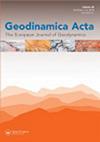土耳其西安纳托利亚Menderes地块晚新元古代麻粒岩相变质作用:对冈瓦纳组合的启示
IF 1.5
Q1 Earth and Planetary Sciences
引用次数: 19
摘要
门德勒斯地块是土耳其西部一个主要的多变质杂岩。晚新元古代基底由部分杂化的副长岩和变质长岩组成,并伴有正长岩侵入。基底系列的泥质麻粒岩、副辉岩和含正辉石正长岩(绿绿岩)是主要的麻粒岩相岩性。炭质偏闪长岩和偏闪长岩的成分为镁质,呈钙碱性到碱钙亲和关系。Nd和Sr同位素系统表明均质地壳污染。绿绿岩中的锆石具有无特征的过度生长和边缘结构,代表了岩浆岩心和继承颗粒上的变质生长。charnock岩原岩的结晶年龄为~590 Ma,它们记录了~ 580 Ma的麻粒岩相覆印。这些资料表明,门德列斯地块记录了新元古代晚期岩浆和麻粒岩相变质事件。基底岩在~42 Ma时被始新世巴罗维亚型高山变质作用复盖。现今阿拉伯半岛以北的门德尔斯地块的年代学资料和最新推断的新元古代-早寒武世古地理背景表明,门德尔斯地块的麻粒岩相变质作用可归因于库恩加造山带(600-500 Ma)导致冈瓦纳北部的最终合并过程。本文章由计算机程序翻译,如有差异,请以英文原文为准。
Late Neoproterozoic granulite facies metamorphism in the Menderes Massif, Western Anatolia/Turkey: implication for the assembly of Gondwana
The Menderes Massif is a major polymetamorphic complex in Western Turkey. The late Neoproterozoic basement consists of partially migmatized paragneisses and metapelites in association with orthogneiss intrusions. Pelitic granulite, paragneiss and orthopyroxene-bearing orthogneiss (charnockite) of the basement series form the main granulite-facies lithologies. Charnockitic metagranodiorite and metatonalite are magnesian in composition and show calc-alkalic to alkali-calcic affinities. Nd and Sr isotope systematics indicate homogeneous crustal contamination. The zircons in charnockites contain featureless overgrowth and rim textures representing metamorphic growth on magmatic cores and inherited grains. Charnockites yield crytallization age of ~590 Ma for protoliths and they record granulite-facies overprint at ~ 580 Ma. These data indicate that the Menderes Massif records late Neoproterozoic magmatic and granulite-facies metamorphic events. Furthermore, the basement rocks have been overprinted by Eocene Barrovian-type Alpine metamorphism at ~42 Ma. The geochronological data and inferred latest Neoproterozoic–early Cambrian palaeogeographic setting for the Menderes Massif to the north of present-day Arabia indicate that the granulite-facies metamorphism in the Menderes Massif can be attributed to the Kuunga Orogen (600–500 Ma) causing the final amalgamation processes for northern part of the Gondwana.
求助全文
通过发布文献求助,成功后即可免费获取论文全文。
去求助
来源期刊

Geodinamica Acta
地学-地球科学综合
CiteScore
4.50
自引率
0.00%
发文量
0
审稿时长
25 weeks
期刊介绍:
Geodinamica Acta provides an international and interdisciplinary forum for the publication of results of recent research dealing with both internal and external geodynamics. Its aims to promote discussion between the various disciplines that work on the dynamics of the lithosphere and hydrosphere. There are no constraints over themes, provided the main thrust of the paper relates to Earth''s internal and external geodynamics. The Journal encourages the submission of papers in all fields of earth sciences, such as biostratigraphy, geochemistry, geochronology and thermochronology, geohazards and their societal impacts, geomorphology, geophysics, glaciology, igneous and metamorphic petrology, magmatism, marine geology, metamorphism, mineral-deposits and energy resources, mineralogy, orogeny, palaeoclimatology, palaeoecology, paleoceanograpgy, palaeontology, petroleum geology, sedimentology, seismology and earthquakes, stratigraphy, structural geology, surface processes, tectonics (neoteoctonic, plate tectonics, seismo-tectonics, Active tectonics) and volcanism.
Geodinamica Acta publishes high quality, peer-reviewed original and timely scientific papers, comprehensive review articles on hot topics of current interest, rapid communications relating to a significant advance in the earth sciences with broad interest, and discussions of papers that have already appeared in recent issues of the journal. Book reviews are also included. Submitted papers must have international appeal and regional implications; they should present work that would be of interest to many different specialists. Geographic coverage is global and work on any part of the world is considered. The Journal also publishes thematic sets of papers on topical aspects of earth sciences or special issues of selected papers from conferences.
 求助内容:
求助内容: 应助结果提醒方式:
应助结果提醒方式:


